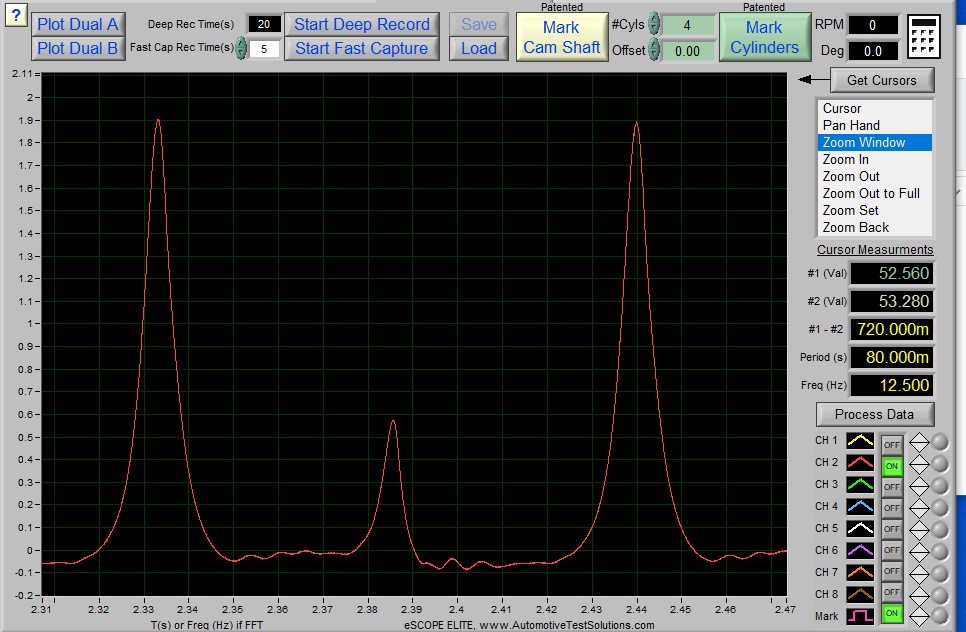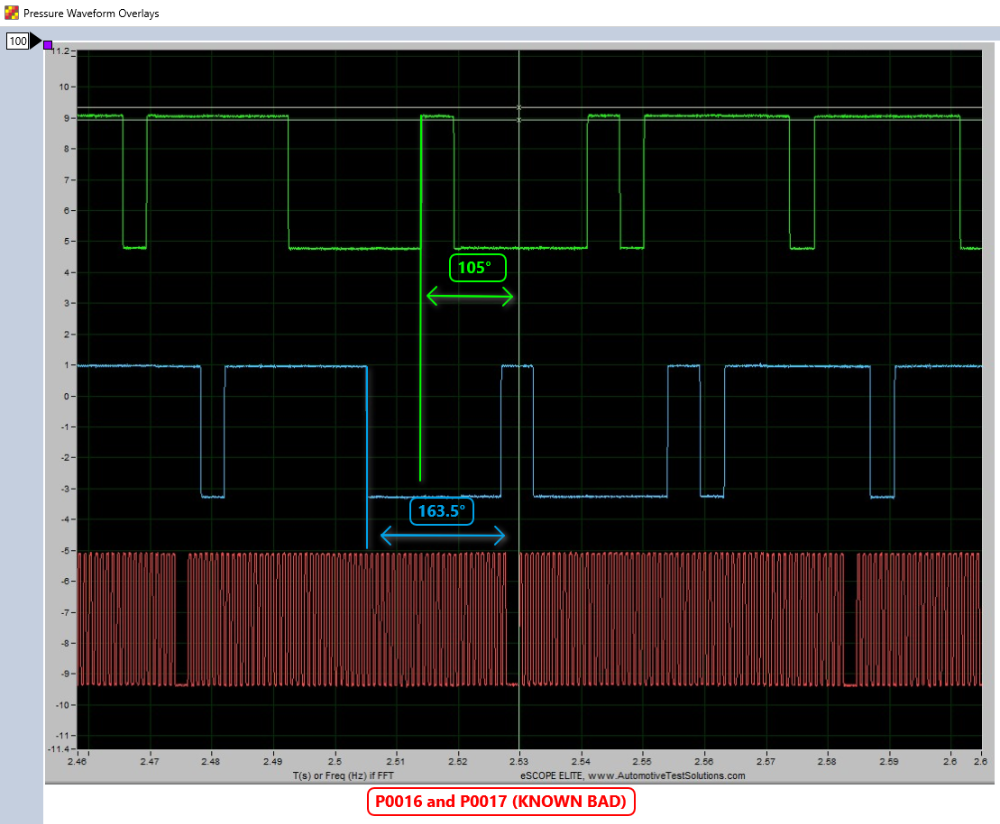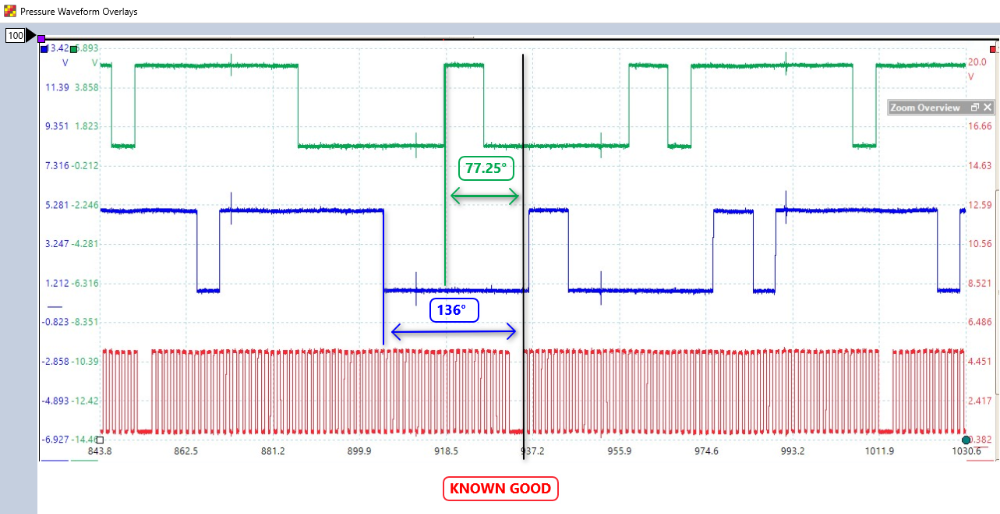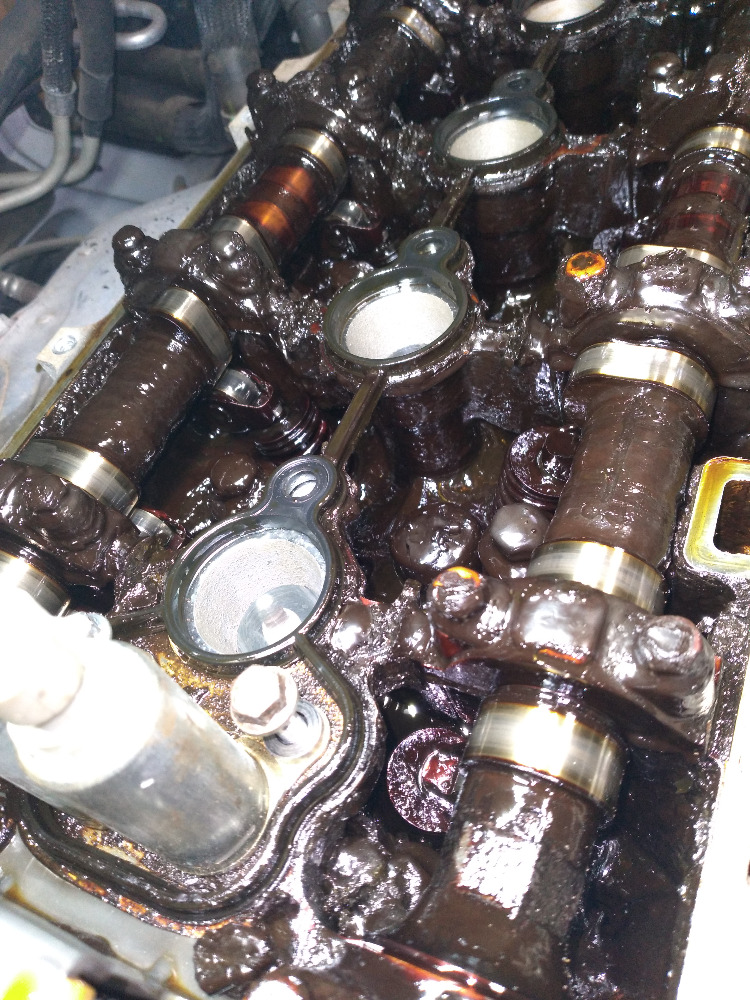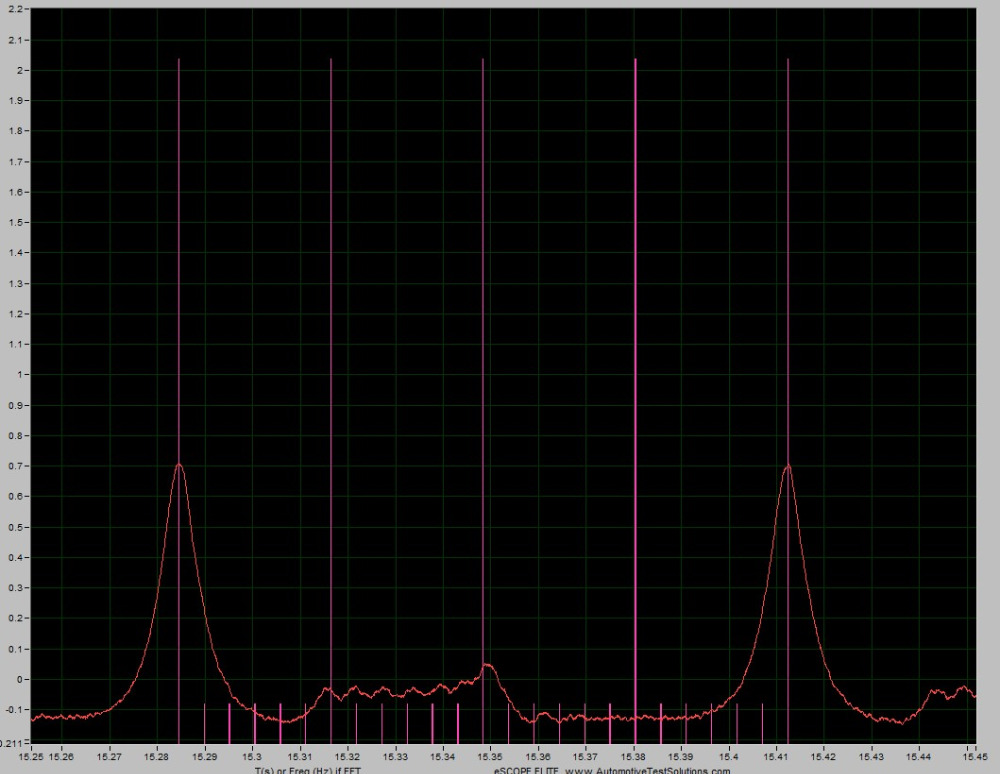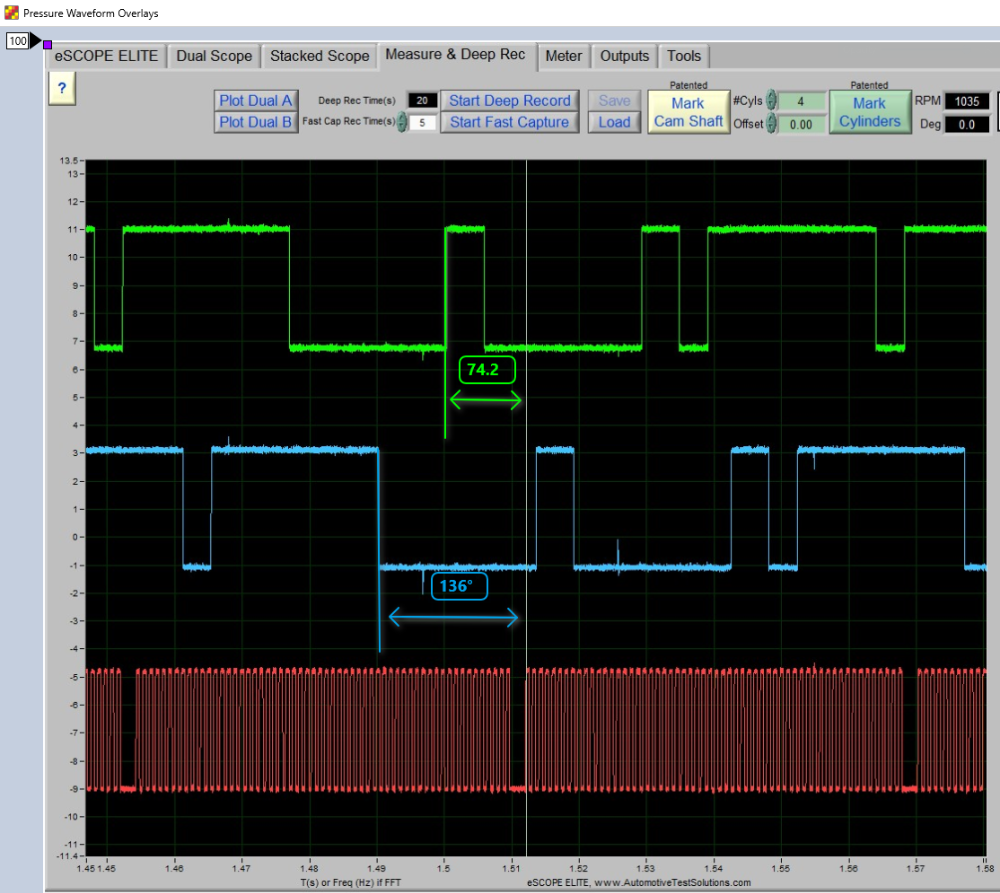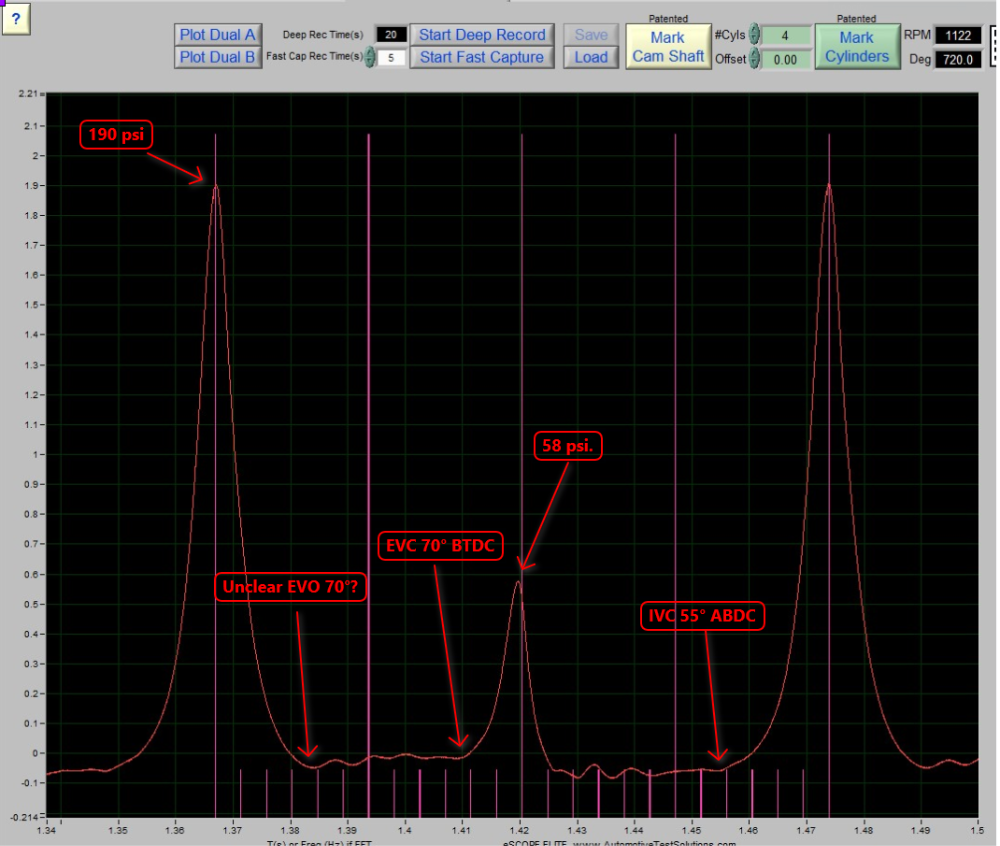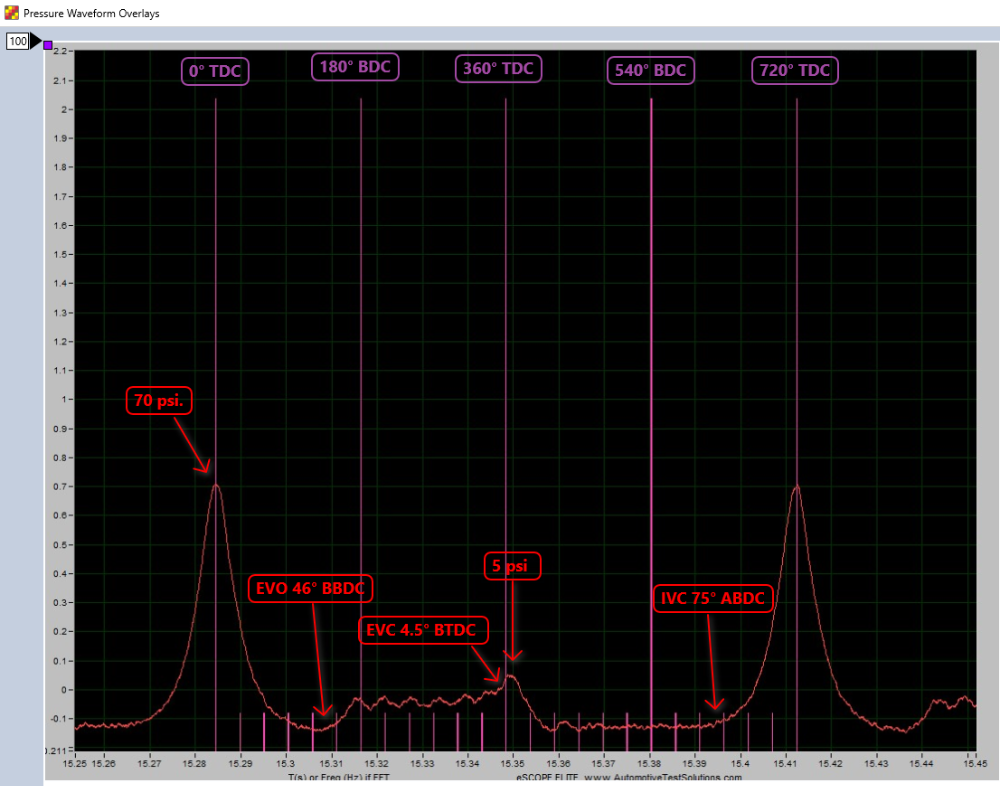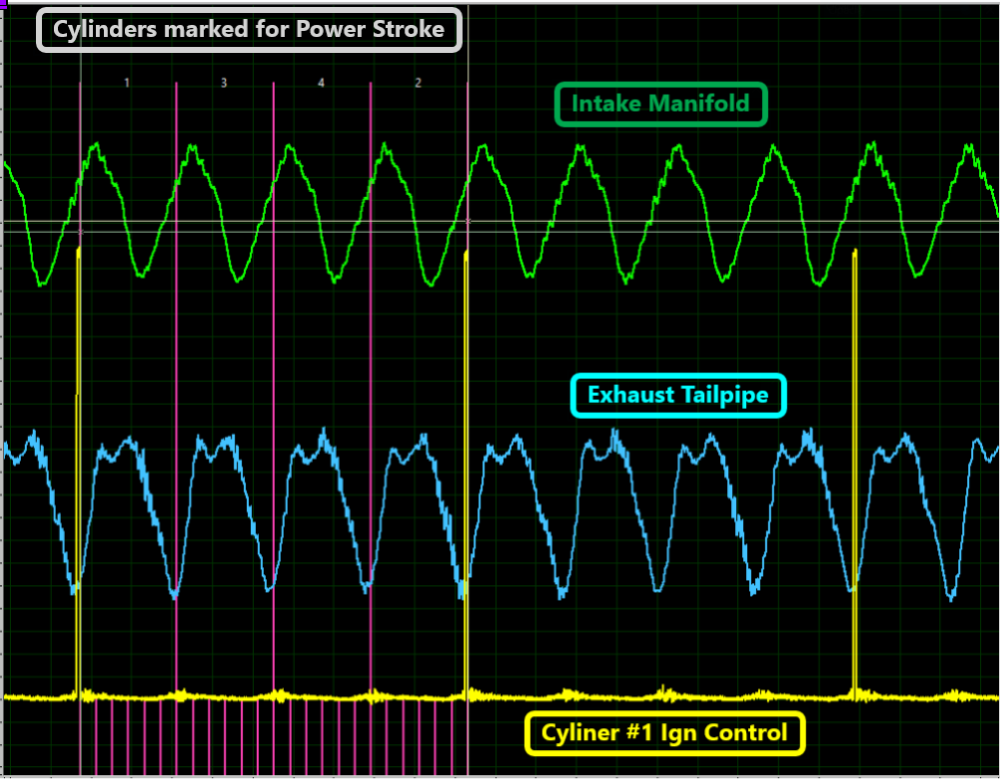*** Restricting New Posts to SD Premium Members ONLY *** (09 May 2025)
Just made a new account? Can't post? Click above.
Confirming a Timing issue with In-cylinder and Cam/Crank correlation waveforms
- Chad
-
 Topic Author
Topic Author
- Offline
- Moderator
-

- I am not a parts changer.
Less
More
- Posts: 2125
- Thank you received: 710
4 years 10 months ago - 4 years 10 months ago #45133
by Chad
"Knowledge is a weapon. Arm yourself, well, before going to do battle."
"Understanding a question is half an answer."
I have learned more by being wrong, than I have by being right.
Confirming a Timing issue with In-cylinder and Cam/Crank correlation waveforms was created by Chad
2012 Chevy Malibu 2.4
Complaint: Rough Idle, Low Power, and CEL (P0016 and P0017) Customer stated that a friend installed a new timing kit, about 1 1/2 years ago.
In-cylinder pressure waveform shows an abnormal pressure spike in the exhaust stroke, indicating early EVC. Running compression is 190 psi.
Next, is a capture of Cam And Crank Correlation
Known Good Cam And Crank Correlation
Subtracting the Known Good values from the Suspected Bad values gives us a difference of 27.75° on the Intake Cam. And, 27.5° on the exhaust.
Reading the waveform from left to right, the Suspect timing events are happening BEFORE they should. This timing is advanced, confirming our suspicions of the In-cylinder pressure waveform.
The customer "OK"ed the repair. I pulled the valve cover off and saw one of the most sludged-up engines I have ever seen (this one ranks, probably, #3). You can, also, see the wear marks on the cam lobes.
The picture doesn't, really, do it justice.
I called the customer in and voiced my concerns about oil pressure/circulation, and recommended that he consider other options. He wanted me to continue with the timing kit, and accepted that there would be no guarantee/warranty.
Continuing on, I saw that all of the timing components were, in fact, new with the exception of the phasers. However, both guides were broken, and the crank shaft was off by two(?) teeth.
360°/23 teeth = 15.652° per crank sprocket tooth.
Everything back together, and this is the In-cylinder waveform:
Notice there is, still, a small hump at the end of the exhaust stroke. I believe this is due to the cam lobes being worn. ( I checked 3 out of 4 cylinders. All of them had this hump.) Worn cam lobes will cause a valve to open late, and close early.
Complaint: Rough Idle, Low Power, and CEL (P0016 and P0017) Customer stated that a friend installed a new timing kit, about 1 1/2 years ago.
In-cylinder pressure waveform shows an abnormal pressure spike in the exhaust stroke, indicating early EVC. Running compression is 190 psi.
Next, is a capture of Cam And Crank Correlation
Known Good Cam And Crank Correlation
Subtracting the Known Good values from the Suspected Bad values gives us a difference of 27.75° on the Intake Cam. And, 27.5° on the exhaust.
Reading the waveform from left to right, the Suspect timing events are happening BEFORE they should. This timing is advanced, confirming our suspicions of the In-cylinder pressure waveform.
The customer "OK"ed the repair. I pulled the valve cover off and saw one of the most sludged-up engines I have ever seen (this one ranks, probably, #3). You can, also, see the wear marks on the cam lobes.
The picture doesn't, really, do it justice.
I called the customer in and voiced my concerns about oil pressure/circulation, and recommended that he consider other options. He wanted me to continue with the timing kit, and accepted that there would be no guarantee/warranty.
Continuing on, I saw that all of the timing components were, in fact, new with the exception of the phasers. However, both guides were broken, and the crank shaft was off by two(?) teeth.
360°/23 teeth = 15.652° per crank sprocket tooth.
Everything back together, and this is the In-cylinder waveform:
Notice there is, still, a small hump at the end of the exhaust stroke. I believe this is due to the cam lobes being worn. ( I checked 3 out of 4 cylinders. All of them had this hump.) Worn cam lobes will cause a valve to open late, and close early.
"Knowledge is a weapon. Arm yourself, well, before going to do battle."
"Understanding a question is half an answer."
I have learned more by being wrong, than I have by being right.
Last edit: 4 years 10 months ago by Chad.
Please Log in or Create an account to join the conversation.
- Chad
-
 Topic Author
Topic Author
- Offline
- Moderator
-

- I am not a parts changer.
Less
More
- Posts: 2125
- Thank you received: 710
4 years 10 months ago - 4 years 10 months ago #45134
by Chad
"Knowledge is a weapon. Arm yourself, well, before going to do battle."
"Understanding a question is half an answer."
I have learned more by being wrong, than I have by being right.
Replied by Chad on topic Confirming a Timing issue with In-cylinder and Cam/Crank correlation waveforms
To confirm timing, I re-captured Cam and Crank correlation.
Exhaust cam matches the "Known Good", exactly. The Intake cam has a few degrees difference. I have checked multiple "Known Good" files. They all have a few degrees of variance.
In-Cylinder - BEFORE
In-Cylinder - AFTER
Exhaust cam matches the "Known Good", exactly. The Intake cam has a few degrees difference. I have checked multiple "Known Good" files. They all have a few degrees of variance.
In-Cylinder - BEFORE
In-Cylinder - AFTER
"Knowledge is a weapon. Arm yourself, well, before going to do battle."
"Understanding a question is half an answer."
I have learned more by being wrong, than I have by being right.
Last edit: 4 years 10 months ago by Chad.
Please Log in or Create an account to join the conversation.
- Noah
-

- Offline
- Moderator
-

- Give code definitions with numbers!
Less
More
- Posts: 4931
- Thank you received: 1100
4 years 10 months ago #45262
by Noah
"Ground cannot be checked with a 10mm socket"
Replied by Noah on topic Confirming a Timing issue with In-cylinder and Cam/Crank correlation waveforms
That thing looks sad! Short trips, not making it up to temp and lack of maintenance?
I've noticed a similar rise in pressure at the end of the exhaust stroke on engines with no apparent issue, but never really had the time to investigate the cause.
I suspected VVT making minimum (no) over lap at idle to minimize EGR effect, but don't have any proof. Worn cam lobe makes sense.
Did you notice if the other cylinders had the same rise in pressure?
Thanks for sharing Chad, quality work as always!
I've noticed a similar rise in pressure at the end of the exhaust stroke on engines with no apparent issue, but never really had the time to investigate the cause.
I suspected VVT making minimum (no) over lap at idle to minimize EGR effect, but don't have any proof. Worn cam lobe makes sense.
Did you notice if the other cylinders had the same rise in pressure?
Thanks for sharing Chad, quality work as always!
"Ground cannot be checked with a 10mm socket"
Please Log in or Create an account to join the conversation.
- Chad
-
 Topic Author
Topic Author
- Offline
- Moderator
-

- I am not a parts changer.
Less
More
- Posts: 2125
- Thank you received: 710
4 years 10 months ago - 4 years 10 months ago #45264
by Chad
I checked Cylinders 1, 2, and 3. The Hump was there in all 3. Then, laziness got the best of me, and I assumed cylinder #4 was the same.
I, also, captured Intake Manifold pressure, and Tailpipe Exhaust. Relatively, all cylinders look good? The overlap "M", in the Exhaust waveform, is there. But, it's smaller than I am use to seeing. I will capture a Know Good, sometime, and compare.
That's good reasoning, and makes since. In this case, though, the solenoids are disconnected.
In this case, though, the solenoids are disconnected.
"Knowledge is a weapon. Arm yourself, well, before going to do battle."
"Understanding a question is half an answer."
I have learned more by being wrong, than I have by being right.
Replied by Chad on topic Confirming a Timing issue with In-cylinder and Cam/Crank correlation waveforms
Did you notice if the other cylinders had the same rise in pressure?
I checked Cylinders 1, 2, and 3. The Hump was there in all 3. Then, laziness got the best of me, and I assumed cylinder #4 was the same.
I, also, captured Intake Manifold pressure, and Tailpipe Exhaust. Relatively, all cylinders look good? The overlap "M", in the Exhaust waveform, is there. But, it's smaller than I am use to seeing. I will capture a Know Good, sometime, and compare.
I suspected VVT making minimum (no) over lap at idle to minimize EGR effect
That's good reasoning, and makes since.
"Knowledge is a weapon. Arm yourself, well, before going to do battle."
"Understanding a question is half an answer."
I have learned more by being wrong, than I have by being right.
Last edit: 4 years 10 months ago by Chad.
The following user(s) said Thank You: Noah
Please Log in or Create an account to join the conversation.
- Matt T
-
- Offline
- Platinum Member
-

Less
More
- Posts: 751
- Thank you received: 276
4 years 10 months ago #45274
by Matt T
IIRC one of the engines you found that TDC exhaust hump on did have enough phaser travel to cause zero overlap. Difficult to say that is the cause without knowing what the PCM is commanding though.
The phasers may move to their minimum overlap positions as a default when control is removed.
Replied by Matt T on topic Confirming a Timing issue with In-cylinder and Cam/Crank correlation waveforms
I suspected VVT making minimum (no) over lap at idle to minimize EGR effect
IIRC one of the engines you found that TDC exhaust hump on did have enough phaser travel to cause zero overlap. Difficult to say that is the cause without knowing what the PCM is commanding though.
That's good reasoning, and makes since.
In this case, though, the solenoids are disconnected.
The phasers may move to their minimum overlap positions as a default when control is removed.
The following user(s) said Thank You: Noah, Chad
Please Log in or Create an account to join the conversation.
- Noah
-

- Offline
- Moderator
-

- Give code definitions with numbers!
Less
More
- Posts: 4931
- Thank you received: 1100
4 years 10 months ago #45381
by Noah
"Ground cannot be checked with a 10mm socket"
Replied by Noah on topic Confirming a Timing issue with In-cylinder and Cam/Crank correlation waveforms
That exhaust pattern does appear to confirm that overlap is occurring, based on what I have read any way. I haven't used my pulse tester in the tailpipe to confirm an issue yet.
"Ground cannot be checked with a 10mm socket"
Please Log in or Create an account to join the conversation.
Time to create page: 0.290 seconds

